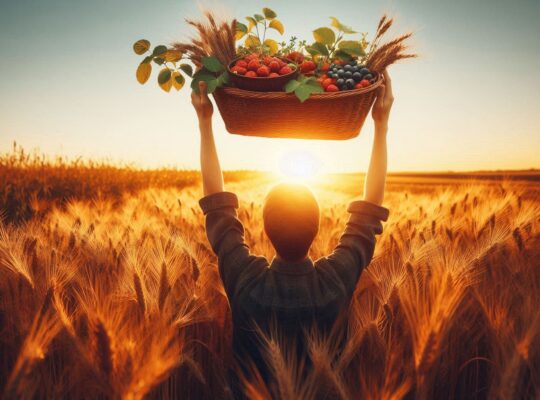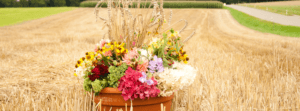Mabon’s Healing Harvest: Celebrating Autumn’s Balance
As golden leaves begin to fall and the air grows crisp with autumn’s first breath, the Wheel of the Year turns to welcome Mabon, the Fall Equinox. This special time marks perfect balance between light and darkness—equal hours of day and night—before we begin the gentle descent into winter’s restful months. Mabon invites us to gather our harvest, both physical and spiritual, to give thanks for summer’s gifts, and to prepare for the more introspective season ahead. In this guide, we’ll explore simple ways to bring Mabon’s balancing energy into your life with rituals that honor both the abundance of harvest and the wisdom of release.
When Mabon’s Balance Arrives
Mabon occurs between September 21st and 23rd each year in the Northern Hemisphere. In 2025, we’ll celebrate on Monday, September 22nd. This meaningful holiday marks the Autumn Equinox, when day and night stand in perfect equilibrium before darkness gradually grows longer.
After Lughnasadh’s first harvest celebration in August, Mabon brings us to the second harvest—a time to gather fall’s abundant fruits, nuts, and late vegetables. The name “Mabon” comes from Welsh mythology, referring to a divine figure associated with youthful energy and the cycles of life.
The Autumn Equinox has been celebrated by cultures worldwide for thousands of years, honoring this pivotal turning point when summer officially transitions to fall. Traditional celebrations included harvest feasts, expressing gratitude for nature’s gifts, and preparing for the coming winter months.
Mabon teaches us about balance—finding harmony between light and dark, work and rest, giving and receiving. This makes it a perfect time for healing practices that help us find our center amid life’s constant changes.
Ancient Wisdom of Mabon
For thousands of years, people have marked the Autumn Equinox with rituals of thanksgiving and preparation. Our ancestors understood that this moment marked an important transition—when the abundance of summer began giving way to winter’s necessary rest.
In Celtic traditions, this second harvest festival was a time for gathering the last fruits of summer, storing food for winter, and celebrating community bonds that would help sustain everyone through the coming cold months. Feasts featured foods from the harvest, while rituals honored the changing season.
Greek mythology tells us the story of Persephone returning to the Underworld at this time, beginning her annual stay with Hades that creates autumn and winter. This powerful myth reminds us that cycles of presence and absence, growth and rest, are natural parts of life’s journey.
Many ancient monuments, like Stonehenge in England and Chichen Itza in Mexico, were built to align with the equinoxes. On these special days, sunlight creates unique patterns that marked this important balance point for early civilizations who closely followed nature’s cycles.
When we celebrate Mabon today, we join this long line of people who have paused to acknowledge the changing seasons. Their simple wisdom teaches us that taking time to express gratitude for abundance while preparing for leaner times helps us maintain balance in our own lives.
Mabon’s Special Symbols
Mabon gives us meaningful symbols that connect us to autumn’s healing energy. The scales represent perfect balance between opposing forces—light and dark, giving and receiving, action and rest. You might use actual scales on your altar or simply visualize this balance in your meditation practice.
Apples become especially sacred at Mabon, representing wisdom, immortality, and the harvest of our efforts. Cutting an apple horizontally reveals a hidden five-pointed star inside—a pentacle of protection and magical knowledge. Sharing apples with loved ones connects you to this ancient symbol of knowledge and abundance.
The cornucopia (horn of plenty) embodies the harvest’s generosity—an overflowing container of fruits, vegetables, grains, and flowers. Creating or displaying a cornucopia reminds us to recognize and appreciate the many forms of abundance in our lives.
Colorful leaves in their stunning transformation teach us about the beauty of letting go. As trees release their leaves in brilliant displays of orange, red, and gold, we learn that release can be as beautiful as growth. Collecting fallen leaves for crafts or altar decorations honors this wisdom.
Acorns and nuts represent potential and future growth contained in small packages. The mighty oak lives first as a tiny acorn, teaching us that great things often have humble beginnings. Gathering acorns or pinecones connects us to this cycle of potential, dormancy, and future growth.
Simple Mabon Rituals for Healing
Creating an apple gratitude ritual offers a beautiful way to connect with Mabon’s energy. Gather with friends or family around a bowl of apples. Each person takes one, and before eating, shares something they’re grateful for from the past season. As you eat your apple, visualize taking in the sweetness of life along with the wisdom of your experiences.
A balance meditation helps align you with Mabon’s perfect equilibrium. Sit quietly outdoors if possible, or near a window where you can see nature. Hold something light in your right hand (perhaps a white feather) and something dark in your left (maybe a small stone). Close your eyes and breathe deeply, imagining these energies flowing together in perfect harmony within you.
Making a gratitude jar becomes a powerful ongoing ritual. Decorate a jar with autumn symbols like leaves or acorns. Each day, write one blessing on a small piece of paper and place it in the jar. By winter solstice, you’ll have a collection of memories to remind you of life’s goodness during the darker season.
The sunset release ceremony helps you let go of what no longer serves you. Write on fallen leaves what you wish to release—perhaps habits, grudges, or limiting beliefs. At sunset on Mabon, release these leaves into moving water, bury them in the earth, or (safely) burn them while giving thanks for their lessons.
Healing Plants of Mabon
As autumn paints the landscape with warm colors, certain plants offer special healing benefits:
- Apples reach their perfect ripeness now, offering both physical nourishment and spiritual symbolism. Making apple tea (by simmering apple slices with cinnamon) creates a warm drink that supports digestion while connecting you to this ancient symbol of wisdom. Save the seeds to plant or use in prosperity charms, remembering to remove any coating if planting.
- Rosehips, the fruit of wild roses, turn bright red at Mabon, signaling their readiness for harvest. These vitamin C-rich berries support immune health as we enter cold season. Gathering rosehips connects you to wild places while providing medicine for winter wellness. Dried rosehips make a tart, nutritious tea that helps prevent winter colds.
- Oak leaves and acorns bring strength and grounding energy. The mighty oak was sacred to druids and many ancient cultures as a symbol of endurance and wisdom. Collecting fallen acorns or oak leaves for your altar honors this tree’s medicine of stability during times of change.
- Sage grows abundant and aromatic at harvest time. Whether you use garden sage for cooking and tea or white sage for cleansing spaces (when ethically sourced), this plant offers purification as we prepare to spend more time indoors. A bundle of dried garden sage makes a wonderful cleansing tool while supporting respiratory health.
- Elderberries ripen to deep purple-black in early fall, offering powerful immune support just when we need it most. These traditional berries help prevent winter illness when made into syrup or tea. Harvesting elderberries (making sure to properly identify them and never eat them raw) connects you to ancestral healing traditions.
Creating Your Mabon Altar
Your Mabon altar becomes a focal point for autumn’s balanced energies—a sacred space where gratitude meets introspection. Create this space with mindful presence, letting your heart guide what feels right.
Fresh or dried flowers in autumn colors bring natural beauty—sunflowers, marigolds, and late-blooming asters work beautifully. Arrange them in a vase with fallen leaves or autumn grasses for a display that honors the seasonal transition.
Candles in gold, orange, brown, or deep red represent Mabon’s fire. As you light each one, speak a blessing of gratitude for something that has enriched your life. Gold candles represent the sun’s continuing presence; orange symbolizes creativity and joy; brown honors the earth; red acknowledges passion and vitality.
Add symbols of the harvest—apples, pears, nuts, pumpkins, gourds, or grains. A small basket or bowl filled with these fruits creates a beautiful centerpiece that reminds us of earth’s generosity. If possible, include items you’ve grown or gathered yourself.
Crystals that support Mabon’s energy include tiger’s eye for balance and grounding, carnelian for creativity and courage during change, and clear quartz to amplify your intentions. Place these stones in sunlight before adding them to your altar.
Fall leaves in vibrant colors represent the beauty of transformation and release. Collect especially beautiful specimens and press them between book pages before adding them to your altar. You might arrange them in a circle to represent the continuing cycle of seasons.
Let your altar evolve throughout the Mabon season, perhaps adding acorns from your walks or symbols of personal harvests as you recognize them. This sacred space honors both the outer turning of the Wheel and your inner journey toward wholeness and healing.
Foods for Mabon Celebration
Mabon is the perfect time to enjoy the final bounty of summer alongside autumn’s first offerings. Creating a meal that features local seasonal foods honors the earth’s cycles while providing maximum nutrition from freshly harvested ingredients.
Apples and pears feature prominently in traditional Mabon feasts, representing the fruits of our efforts. Baking these fruits with cinnamon, nutmeg, and honey creates a simple dessert that fills your home with the scent of autumn. Sharing apple-based treats connects you to ancient harvest customs while providing antioxidants and fiber.
Root vegetables like carrots, potatoes, onions, and beets represent grounding and the transition to heartier foods as weather cools. Roasting these vegetables with herbs creates a colorful, nourishing dish that connects you to what grows beneath the soil—the hidden foundation that supports all visible growth.
Nuts and seeds become especially appropriate at Mabon, symbolizing potential and stored energy. Adding walnuts, hazelnuts, sunflower seeds, or pumpkin seeds to salads, breads, or desserts brings texture and protein-rich nourishment. Toast pumpkin seeds with a little salt for a simple, mineral-rich snack.
Wine or grape juice honors the traditional grape harvest that often occurs around Mabon. Sharing a glass with your meal connects you to ancient celebrations of Dionysus or Bacchus, gods associated with the grapevine and its transformation. For a non-alcoholic option, sparkling grape juice or berry-infused water brings festive energy.
Fresh bread, especially whole grain varieties, represents the grain harvest that sustains us through winter. Breaking bread with loved ones creates sacred community, while the aroma of baking fills your home with comfort as days grow shorter.
Approach cooking as a sacred act—a way to bring nature’s healing energy into your body. Let each bite connect you to Mabon’s celebration of harvest, balance, and gratitude for life’s abundance.
Divine Guides of Mabon
The spiritual beings connected to Mabon can support your seasonal journey. Think of them as helpful energies rather than distant figures—aspects of wisdom that you can connect with through intention and awareness.
Demeter and Persephone from Greek mythology embody the mother-daughter relationship that explains the changing seasons. As Persephone returns to the Underworld at Mabon, Demeter’s grief creates autumn and winter. Their story teaches us about necessary cycles of presence and absence, growth and rest. Connect with their energy when navigating transitions or practicing letting go with grace.
Mabon ap Modron, from Welsh legends, gives this sabbat its name. As a divine youth figure associated with the hunt and nature’s cycles, he represents the energies of early autumn—still vibrant but beginning to slow. His energy supports balance between action and reflection, helping us maintain vitality while honoring the need for increasing rest.
The Green Man, often depicted as a face made of leaves and vines, represents the wild masculine energy of nature as it begins its transition toward winter dormancy. His image carved in stone appears in ancient churches throughout Europe, showing how this nature deity persisted even as religions changed. Connect with him when seeking to understand natural cycles of growth and release.
Harvest deities from various traditions—like Ceres (Roman), Freyr (Norse), or Xilonen (Aztec)—embody gratitude for earth’s abundance. These divine energies remind us to acknowledge the sources of our nourishment and to share our plenty with others. Work with them when practicing gratitude or when sharing your own abundance.
These divine energies exist both in the world around us and within our own consciousness. They don’t require elaborate rituals—just an open heart and willingness to recognize their qualities in nature and within yourself.
Community Healing at Mabon
Mabon traditionally brings people together to celebrate harvest and prepare for winter. This social aspect reminds us that balancing our lives becomes easier when we have community support and connection.
Consider hosting a harvest potluck where everyone brings a dish featuring seasonal ingredients. This creates a feast that honors autumn’s bounty while strengthening community bonds. The shared meal becomes more than physical nourishment—it feeds our human need for connection and celebration.
Food banks and community pantries often need donations before winter’s challenges arrive. Organizing a food drive or contributing non-perishable items honors Mabon’s themes of harvest and sharing abundance. This practical form of community care extends the circle of giving beyond your immediate group.
Community cleanup projects align perfectly with Mabon’s energy of preparation. Gathering friends to clear a neighborhood space, prepare a community garden for winter, or help elderly neighbors with fall yard work creates concrete improvements while building relationships that sustain everyone through darker months.
Skill-sharing workshops honor the traditional preparations for winter. Organize a gathering where people teach each other practical skills—perhaps food preservation, knitting, home weatherization, or making herbal remedies. These exchanges build community resilience while honoring each person’s unique gifts.
Through these connections, we embody Mabon’s medicine of balanced giving and receiving. We remember that healing flourishes in community—with each other, with the earth, and with the cycles that sustain all life.
Journal Writing for Mabon Reflection
Writing in a journal helps us process the changes autumn brings and honor our personal harvest. Find a quiet moment outdoors amid falling leaves, light a candle representing Mabon’s balanced light, and explore these questions:
- Where do you feel balance in your life right now? Where do you sense imbalance? Just as the equinox brings equal day and night, what parts of your life need rebalancing? Consider your work and rest, solitude and connection, giving and receiving.
- What have you harvested in your life since spring? Consider both outer accomplishments and inner growth—goals achieved, lessons learned, relationships developed, or insights gained. Acknowledge these fruits of your efforts with genuine appreciation.
- What needs to be released before winter’s introspection? Just as trees let go of leaves that no longer serve them, what might you release—perhaps outgrown habits, completed projects, limiting beliefs, or relationships that have fulfilled their purpose?
- What preparations would help you move smoothly into the darker season? Our ancestors spent autumn preparing practical necessities for winter. What practical, emotional, or spiritual preparations would support your wellbeing as days grow shorter?
- How has your understanding of yourself deepened through this year’s experiences? The apple, cut horizontally, reveals a star pattern hidden inside. What hidden wisdom or strengths have been revealed within you through recent challenges or growth?
- What seeds from this year’s experiences might you carry forward into next spring’s planting? Not all harvests are for immediate use—some provide seeds for future growth. What lessons or ideas seem worth preserving for future development?
Before writing, you might hold an apple or acorn in your hands, feeling its substance while acknowledging your own growth and potential. Just as fruits contain the seeds of future trees, your experiences contain wisdom that may flower in unexpected ways in seasons to come.
Tarot Cards for Mabon Insight
Tarot cards offer helpful insights during this balanced time between seasons. These card spreads act as mirrors reflecting both what you’ve harvested and what you might need to release or preserve as winter approaches.
The Harvest and Balance Spread helps identify where you stand at this turning point. Find a quiet space outdoors if possible, or near a window where you can see autumn’s changes. Take three deep breaths, connecting to both earth below and sky above.
Draw your first card asking: “What am I harvesting in my life right now?” This card shows what’s coming to fruition through your efforts—perhaps in your work, relationships, creative endeavors, or personal development.
Your second card answers: “What needs to come into balance?” This card reveals areas where adjustment might bring greater harmony and wellbeing as seasons change.
The third card guides you toward release by asking: “What am I ready to let go of?” This card shows what might be completed or released, making space for winter’s rest and reflection.
Your final card illuminates wisdom by answering: “What lesson from this year’s growth should I carry forward?” This card helps you identify the most important learning to preserve from recent experiences.
After completing your reading, sit quietly with the insights revealed. Rather than rushing to action, let the wisdom settle like leaves gently falling to earth. Perhaps place a significant card on your Mabon altar as a reminder of your current place in the cycle.
Equal Day and Night: A Simple Mabon Ritual
As Mabon approaches, prepare for a ritual that honors the balance of light and dark, what you’ve harvested, and what you’re ready to release. This ceremony creates space to express gratitude, acknowledge growth, and prepare for the more introspective season ahead.
Gather these items: a candle in gold, red or orange; two small bowls (one filled with fall fruits or grains, one empty); a cup of apple cider or tea; fallen leaves in various colors; and something that represents a personal achievement or growth from the past season.
Create sacred space through cleansing—perhaps by burning dried garden herbs like rosemary or sage, ringing a bell, or simply visualizing golden-orange light filling your space and clearing any heavy energy. Arrange your materials somewhere special where you feel connected to both earth and sky.
Begin your ceremony by sitting or standing quietly, holding your symbol of personal harvest. Reflect on the efforts, challenges, learning, and growth involved in this achievement. Express gratitude to yourself and any others who supported you in this growth.
Light your candle, speaking words that honor Mabon’s balanced energy: “I welcome Mabon’s harmony between light and darkness. May it bring balance to my life, illuminate my path, and help me recognize both my harvest and what I’m ready to release.” Pause to watch the flame, reflecting on how light and shadow dance together.
Take each piece of fruit or grain from your “harvest” bowl one at a time. For each, name something you’re grateful for from the past growing season. It might be an accomplishment, a relationship, a lesson learned, or a challenge overcome. Place each back in the bowl after acknowledging it.
Now take each fallen leaf, one at a time. For each, name something you’re ready to release—perhaps a limiting belief, an outgrown habit, a completed project, or a burden you’ve carried long enough. Place each leaf in the empty bowl, visualizing a lightening of your spirit as you let each one go.
Raise your cup of cider or tea, first offering a few drops to the earth as thanks for its gifts, then taking a drink yourself. Feel this symbolic harvest nourishing you as you move into autumn.
Close your ritual by expressing thanks for the earth’s abundance, the wisdom of seasonal cycles, and your own capacity to both grow and release. Place your candle, harvest bowl, and release bowl on your Mabon altar, letting them remind you of this balancing point between seasons.
In the days following, notice moments when you naturally seek greater balance—perhaps through rest after busy periods, reaching out when you’ve been isolated, or setting boundaries when you’ve given too much. Mabon teaches us that balance isn’t a fixed state but a continuing, dynamic process.
Embracing Mabon’s Balanced Wisdom
As the wheel turns to Mabon, we’re invited to pause at this perfect balancing point—to gather what we’ve grown, to give thanks for abundance, and to prepare for the quieter months ahead. This threshold between summer and fall reminds us that life moves in cycles that include both light and darkness, growth and rest, gathering and releasing.
The changing leaves show us the beauty that comes with letting go—how release itself can become a magnificent display of color and transformation. We too can honor our own cycles, recognizing that releasing what has fulfilled its purpose creates space for future growth.
Mabon whispers to us about the healing that comes from finding equilibrium amid life’s constant changes. In a world that often values constant activity and growth, this sabbat reminds us that balance requires honoring both action and rest, both accomplishment and introspection. The wisdom of our ancestors teaches that taking time to celebrate harvest while preparing for winter’s stillness creates resilience that sustains us through all seasons.
The equal day and night of equinox reminds us that light and dark both play essential roles in the great cycle. By honoring both, we develop greater wholeness and the ability to navigate life’s inevitable transitions with grace.
As you celebrate this special turning point, may you recognize the many ways you’ve grown and the gifts your efforts have yielded. May you find joy in nature’s abundant harvest and wisdom in her cycles of change. May you remember that you are part of nature’s great balance—not separate from the turning seasons but a vital, conscious participant in life’s continuing dance.
The promise of Mabon is that the darkness to come is not something to fear but a necessary complement to light—a time for rest, reflection, and the quiet gestation of new possibilities. Like seeds that require winter’s dormancy before spring’s growth, some dreams and healing require the quiet darkness to develop fully.
Blessed Mabon. May your celebrations be joyful, your harvest abundant, and your heart open to autumn’s golden wisdom.









[…] Mabon 2025 – September 20-24 […]
[…] Mabon 2025 – September 20-24 […]